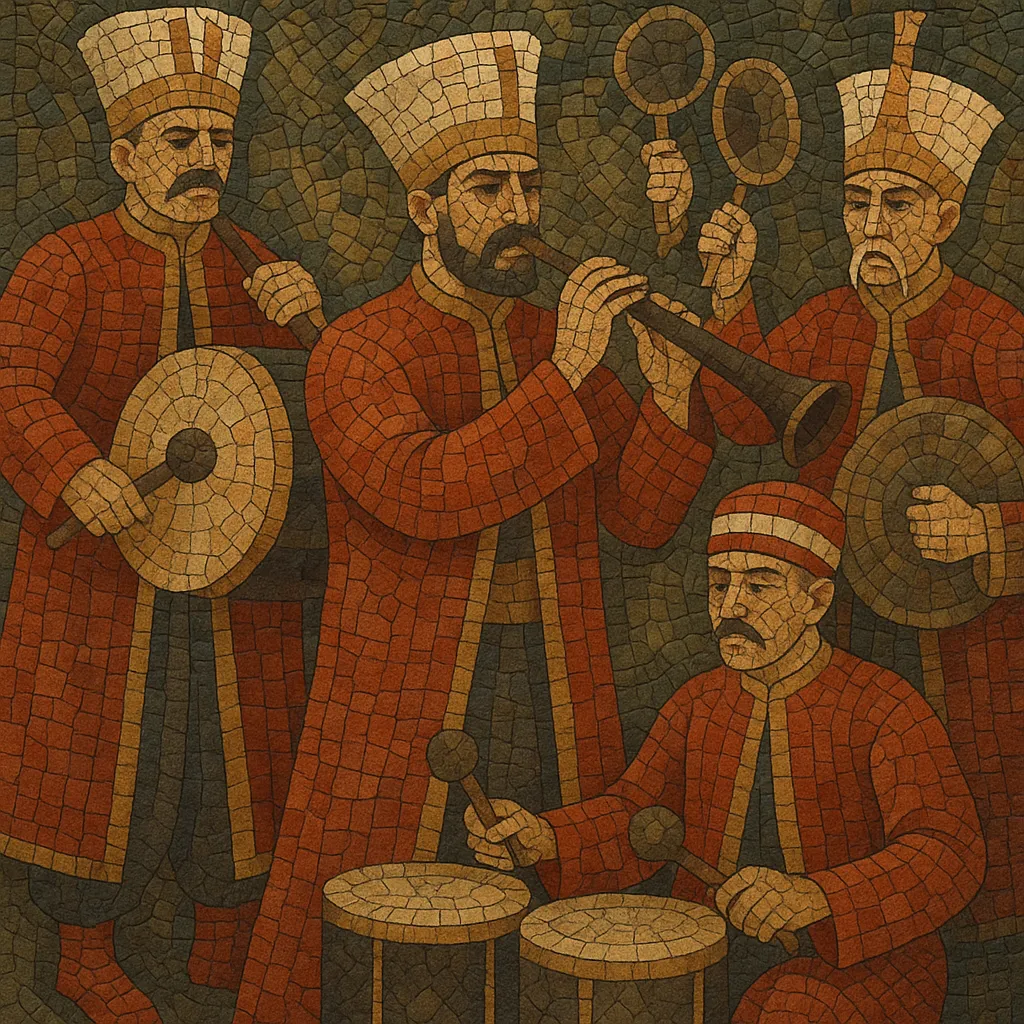Ottoman military music, commonly known as Mehter (Mehterhâne), is the ceremonial and battlefield music of the Ottoman Empire.
It is one of the world's oldest institutionalized military band traditions, characterized by thunderous percussion, piercing shawms (zurnas), and unison, modal melodies in the Ottoman–Turkish makam system.
The ensemble’s core function was to project power, instill courage in troops, and intimidate opponents. Typical instrumentation includes large kettledrums (kös), bass drums (davul), small kettledrums (nakkare), cymbals (zil), natural trumpets (boru), and zurna.
Rhythm is emphatic and processional, often in strong duple meters that support marching and formation movement.
Vocal slogans, calls, and chorus-like refrains amplify the music’s martial and ceremonial aura.
Tradition attributes the establishment of the imperial Mehter to a banner and band bestowed upon Osman I around the foundation of the Ottoman polity (c. 1299). Earlier Turkic and Seljuk martial music practices informed the Ottomans’ courtly and military sound, which soon became a codified institution attached to the Janissary corps.
By the 15th–17th centuries, Mehter had become a prominent sonic emblem of Ottoman sovereignty. Large, tiered ensembles (often described by the number of instrumental “layers,” e.g., six- or nine-layer mehter) performed daily at the palace, accompanied military campaigns, and marked parades and ceremonies. The music employed Ottoman makams (modal frameworks) and usûl (rhythmic cycles), with forceful duple pulses suitable for marching and battlefield projection.
As Ottoman forces and diplomats traveled, European listeners encountered Janissary bands. Their exotic timbres—especially cymbals, bass drums, and triangles—sparked a vogue in European art music. Composers such as Mozart, Haydn, and Beethoven incorporated “alla turca” effects and “Turkish marches,” helping to normalize heavy percussion in Western orchestras and to inspire the development of concert/military band traditions.
In 1826, Sultan Mahmud II abolished the Janissaries (the “Auspicious Incident”) and dissolved the imperial Mehter. A Western-style military music organization (Muzıka-i Hümâyun) was established under Giuseppe Donizetti (Donizetti Paşa). While this marked a shift away from Mehter practice, the Ottoman military music tradition continued in a new, Europeanized idiom.
In the 20th century, a ceremonial Mehter ensemble was reconstituted, most prominently within the Istanbul Military Museum (Askerî Müze). Today, the Mehteran Bölüğü performs at state and cultural events, preserving repertoire, instrumentation, uniforms, and drill, and symbolizing continuity with Ottoman heritage. The sound remains a touchstone for Turkish cultural identity and a historical reference for global military and band music.
Use a traditional Mehter setup: zurna (lead melody), davul (bass drum), nakkare (paired kettledrums), kös (large kettledrums for punctuating climaxes), zil (cymbals), and boru (natural trumpets). Keep timbres bright and projecting; outdoor performance volume and clarity are key.
Favor strong, march-like duple meters (2/4 or 4/4), with emphatic downbeats from davul and kös. Cymbals articulate secondary accents and reinforce cadence points. Typical march tempi range from about 90–110 BPM; keep the pulse steady to support drill and procession.
Compose in Ottoman–Turkish makams (e.g., Rast, Hüseynî, Uşşak, Segâh). Zurna melodies should be modal, stepwise, and declamatory, with ornamental turns and grace notes that suit the instrument’s reedy, strident tone. Favor unison or octave doublings to maximize impact.
Build music in clear sections with repeated strains suitable for marching loops. Use antiphonal exchanges between zurnas and percussion (or between melody and shouted slogans). Cadences are reinforced by tutti drum breaks and cymbal crashes to mark visual formations.
Integrate shouted slogans or choral refrains (e.g., invocations, honorifics, or short patriotic lines) between instrumental strains. Keep texts concise and rhythmically aligned to the march pulse.
Layer percussion to create a “wall of rhythm,” reserving kös for ceremonial peaks. Arrange zurna lines in unison to cut through the ensemble and the open air. Use dynamic swells toward cadence points and processional entries to heighten ceremonial drama.


